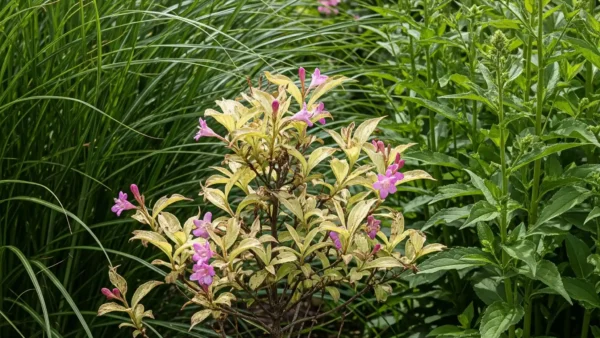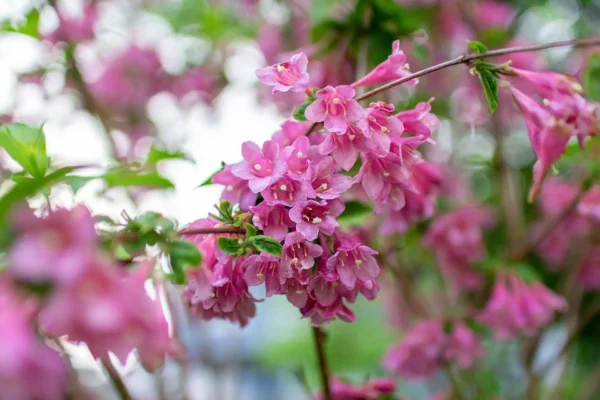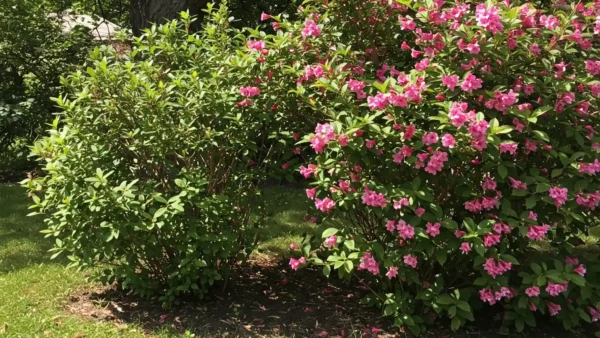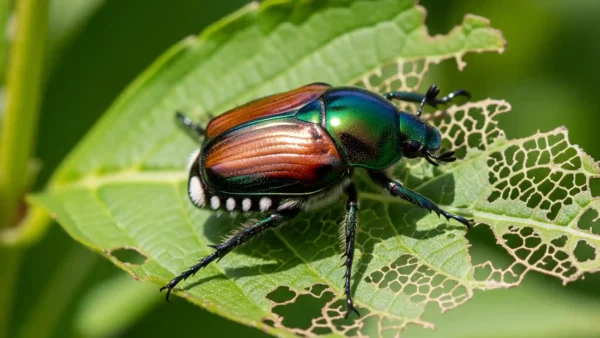Weigela Has Scale! Stop These Waxy Insects Before They Spread
You’ve admired your Weigela’s beautiful, trumpet-shaped blooms all spring, and it has been a consistent star in your garden. But now, as you head into summer, something seems wrong. The leaves, which should be a vibrant green, are beginning to seem a little yellow and are dropping prematurely. A few of the lesser branches seem weak and uninteresting. Perhaps you have also seen a transparent, sticky film on the leaves, which has now evolved into a dusty, black coating. Examining the stems more closely, you find odd, waxy, immovable lumps sticking to the bark. They don’t even look like insects. They just look… wrong.
If this situation sounds familiar, your Weigela has scale. These tiny, armored insects are absolute masters of disguise, mixing in so well that an infestation can get severe before anyone even notices. Though they are a stealthy pest, their steady, silent sucking of life out of your plant can inflict major damage. The good news is that you have already completed the most crucial phase—realizing a problem exists. With correct identification and a prompt, strategic treatment plan, you can totally stop these waxy pests and bring your cherished shrub back to full health.
In this guide, we’ll coach you through a complete battle plan—from basic organic techniques to more powerful treatments—to get rid of them for good. We’ll teach you exactly how to detect scale insects, comprehend their complicated life cycle, and restore your Weigela to its former glory.
Positive ID: What to Look For
Any pest fight starts with determining the nature of your opponent. The adults do not resemble normal bugs with legs and antennae, which is why scale can be challenging to identify. For the most part, they are immobile and blob-like.

The Bumps Themselves
The “scale” you observe is really a protective, waxy covering the insect makes to guard itself from the weather and predators. The small insect is feasting beneath this armor. Usually found concentrated along stems, woody branches, and on the undersides of leaves, especially along the central vein, these bumps might be brown, gray, black, or white. Two primary forms you might come upon are:
- Armored Scale: Like a tiny turtle shell, this kind of scale has a hard, distinct shell that is not attached to the body of the insect. You can often flick this hard cover off with your fingernail to reveal the soft-bodied insect beneath.
- Soft Scale: This kind has a waxy covering that is an inherent part of its body. Removing the covering will squish the bug. Often bigger and more rounded, soft scale insects are the offenders causing the sticky mess in your garden.
The Sticky Cue: Honeydew
If the leaves of your Weigela or the ground and patio beneath it feel sticky, you almost surely have an infestation of soft scale. These insects excrete a sweet, sugary, liquid waste product known as honeydew as they eat the sap of the plant. A strong infestation can generate enough honeydew to drip continuously, coating everything below.

The Secondary Infection: Sooty Mold
A black, powdery fungus called sooty mold finds the ideal growing media in this sticky honeydew. Although the mold itself doesn’t directly damage the tissues of the plant, it looks terrible and can get so thick that it inhibits sunlight from reaching the leaves, thereby interfering with photosynthesis and further weakening the plant. If black “soot” shows up on your plant, look for the pest causing the honeydew—in this case, scale.
What It’s Not: Lenticels
Before you start to panic, examine the branches very closely. All woody stems have small, slightly elevated spots or lines on the bark called lenticels. Like pores in human skin, these are typical, healthy structures the plant uses for gas exchange. Along the stem, lenticels will be uniformly and somewhat irregularly scattered and feel like part of the bark. Conversely, scale insects will be clustered together, usually in crevices, and you can scrape them off with a fingernail.
Why Scale Poses a Major Risk to Your Weigela
Though a scale infestation is a major problem that shouldn’t be overlooked, it’s easy to undervalue these small, immobile bumps.
Sap-Sucking Damage
Using their pointed, straw-like mouthparts and sucking out the essential sap, scale insects feed by puncturing the vascular tissue of plants. Carrying carbohydrates, nutrients, and water to all of the plant’s parts, the sap is its lifeblood. A scale infestation is like a steady, continuous drain of the plant’s energy and resources.
The Consequences
A minor infestation could go unseen and do little damage. But a severe infestation can cause a cascade of symptoms including yellowing leaves (a pattern also known as “stippling”), premature leaf loss, slowed development, and major branch dieback as the plant cannot support those limbs. A strong scale infestation can damage a Weigela so greatly that it finally dies if left completely untreated for multiple seasons.
The Tricky Life Cycle
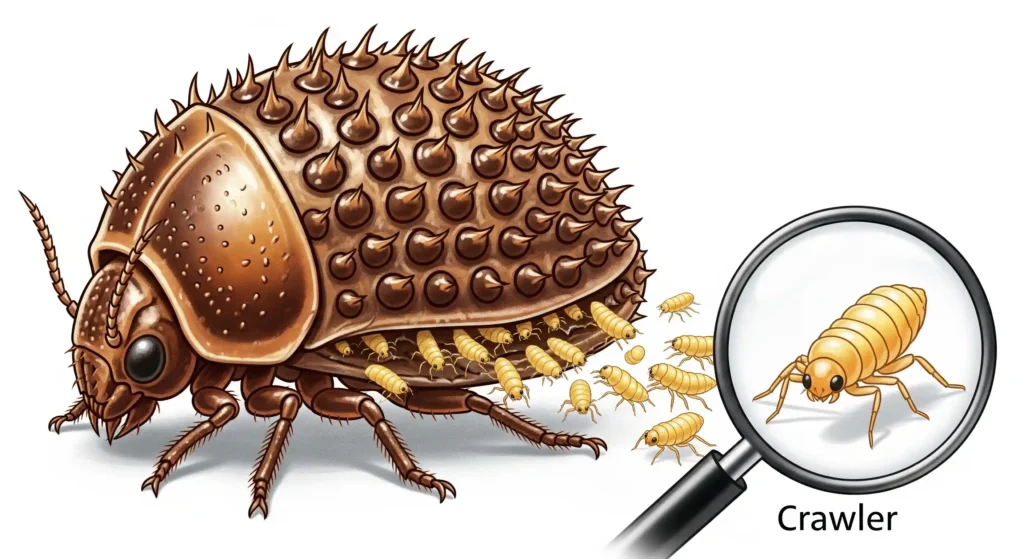
Controlling scale is mostly difficult because of the waxy armor. It shields the adult female from most topical contact pesticides. Effective control depends on knowing and focusing on the “crawler” stage of life, the most susceptible one. After hatching from eggs under the mother’s protective shell, the small, soft-bodied, often yellowish nymphs “crawl” out to locate a new area on the plant to settle down and feed. They are quite sensitive to treatments and have not yet developed their own protective armor during this short mobile period.
Your Battle Plan: How to Eliminate Scale on Weigela
You should start acting once you have confirmed you have scale. Starting with the least dangerous techniques, a multi-pronged approach is always the ideal strategy.
Step 1: Prune and Destroy
Your first move is a physical assault. Remove the most highly affected branches using your cleanest, sharpest pruners. Don’t just dump these branches onto your compost heap, as the scale can carry on their life cycle and disperse. Safely bag them and put them in the trash. This one action can drastically lower the pest population you must deal with.
Step 2: Mechanical Removal
For lesser infestations or the residual bugs left over after pruning, you can physically eliminate them. On smaller shrubs, this is especially handy. To gently scrape or scrub the scale bumps off the branches, you can use a soft-bristled brush—like an old toothbrush—a cotton swab dipped in rubbing alcohol, or even just your fingernail. Look especially at the crevices where branches converge with the main stem.
Step 3: Organic Treatment – The Smothering Method
This is your most efficient and environmentally friendly weapon. Here, the intention is to smother the insects.

- Pro-Tip: The One-Two Punch. For heavy infestations that also have a lot of sticky honeydew and black sooty mold, you can supercharge your treatment. First, give the shrub a complete spray with insecticidal soap. Wait an hour or two, then return and use a powerful stream of water from your hose to rinse the plant off. The soap helps to break down the sooty mold, and the water pressure will wash it away along with many of the scale crawlers. This “cleans the canvas,” allowing your application of horticultural oil to penetrate more effectively and be far more beneficial.
- Horticultural Oil: This is the best organic control for scale because the highly refined oil smothers the insects in all life phases, from eggs to armored adults. The secret is timing your use of the correct oil.
- Dormant Oil: This is a heavier-weight oil that you apply in late winter or very early spring, before the Weigela’s leaf buds start to open. Excellent for eradicating overwintering adult females and their eggs, this application greatly lowers the population before the start of the season.
- Summer Oil: Also known as all-seasons oil, this is a lighter-weight oil suitable for use safely during the growing season when leaves are present. Timing it to target the susceptible crawler stage makes it most successful.
- Pro-Tip: Locate the Crawler Window. Maximum impact from your summer oil spray depends on timing it to coincide with the crawler hatch. This easy approach will help you precisely determine when crawlers are active in your neighborhood: In mid-spring, wrap a piece of black electrical tape, sticky-side-out, across a handful of the afflicted twigs. Use a magnifying glass to check the tape every few days. When you start to notice small, yellowish specks—the crawlers—stuck to the tape, you know the hatch has started and it’s the ideal moment to spray! Since they often track insect life cycles for certain counties, you can also get more exact timing by calling your local cooperative extension service.
Step 4: Chemical Control – The Last Resort
Your last choice might be a systemic insecticide if you have a severe, ongoing infestation endangering the life of your plant. The roots or foliage of the plant absorb these chemicals, which then flow through its sap. Then, while they eat, the scale insects become poisoned. Search for products containing imidacloprid or dinotefuran labeled for use on decorative shrubs to manage scale.
A very significant warning: As the chemical can be present in the nectar and pollen of the plant, systemic insecticides can be detrimental to pollinators such as bees. These products should only be used after the Weigela has ceased flowering for the season to safeguard our essential pollinators.
What Makes a Weigela Vulnerable to Scale?
Remember that, like many diseases, pests are often opportunistic. Their success in attacking already stressed or weakened plants is highest. A strong, healthy plant is far better at resisting an attack. Ask yourself if your Weigela could be experiencing one of these typical stresses after you have addressed the present one:
- Drought Stress: Was the previous summer especially hot and dry? A plant weakened by a lack of continuous water has fewer resources for building robust defenses.
- Bad Location: Where is your Weigela planted? A sun-loving Weigela cultivar grown in deep, dense shade will be constantly strained even if it’s tough. Likewise, planting in thick, watery clay soil may cause root stress.
- Physical Damage: Are there nicks on the lower trunk from a lawnmower or string trimmer? These scars might provide access for infections as well as for pests.
Preventing Future Attacks: Keeping Your Weigela Healthy
Preventing problems is always the greatest long-term plan. Emphasizing appropriate cultural practices will help you to establish an environment in which your Weigela is robust and pests are discouraged.
- Encourage good air circulation. Scale insects live in thick, motionless conditions. Think about a little regeneration pruning once your Weigela blossoms. At the base of the plant, selectively cut out a handful of the thickest, oldest canes. This lets the canopy open, improves airflow, and promotes fresh, new development.
- Inspect New Plants. New plants are the main source of bug introduction into a garden. Examine everything you plan to plant carefully; check the stems, leaf joints, and undersides of leaves for any evidence of problems.
- Promote beneficial insects. You have pals all around your yard! Excellent at controlling scale populations are natural predators such tiny parasitic wasps, ladybugs, and lacewings. Planting a variety of flowering plants and most crucially avoiding the use of broad-spectrum chemical pesticides that can damage these beneficials will help you encourage them.
- The Annual Dormant Oil Spray. Not only for scale but also for many other overwintering pests and their eggs, including a proactive spray of dormant oil as part of your late-winter housekeeping schedule is among the finest preventative actions you can take.
Reclaiming Your Shrub’s Health
You are now completely ready to manage an infestation of Weigela scale, from spotting those unusual waxy lumps right out in the open to designing a comprehensive, multi-step treatment plan. With its stealthy approach and armored fortifications, this pest can look intimidating, yet you are definitely going to win this fight.
Success depends on attention to detail, timing, and awareness, as well as on emphasizing the general condition of your plant. Regular plant inspections, targeted treatments to the vulnerable crawler stage, and ensuring your Weigela is not under too much stress will help you to properly control these pests and preserve the long-term health and beauty of your shrub.
Don’t let these sneaky invaders take center stage. These guidelines will help you to boldly recover your Weigela and look forward to still another season of brilliant, vivid flowers.
Frequently Asked Questions
Will scale destroy my Weigela?
A robust, established shrub won’t likely be killed rapidly. But a severe, untreated infestation that lasts over several years can definitely weaken it to the point of substantial dieback or even death, particularly if the plant is already stressed by other elements like drought.
When should one start treating for scale?
Two perfect windows exist for treatment. The first is with dormant oil to suffocate overwintering adults and eggs in late winter or very early spring, before the leaves show. The second, and most important window, is late spring or early summer with a lighter summer oil to target the most vulnerable stage: the freshly born, mobile “crawlers.”
I find lots of ants all over my Weigela. Do they constitute a concern?
Indeed, but in an indirect sense. Though they are “farming” the scale insects, the ants are not damaging your plant directly. They eat the sweet, sugary honeydew produced by the soft scale. In return, the ants will actively defend the scale from native predators such as ladybugs. Ants moving up and down your shrub are a clear indication of a sap-sucking pest like scale or aphids. Eliminating the scale will drive out the ants.
Could I simply apply rubbing alcohol?
Indeed, a cotton swab or cotton ball bathed in rubbing alcohol can be quite useful for killing and eliminating individual scale insects in a very light infestation on a limited, accessible region. Just dab it on the pest. For a large-scale problem spanning an entire bush, this approach is neither useful nor efficient.




